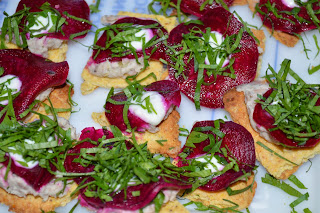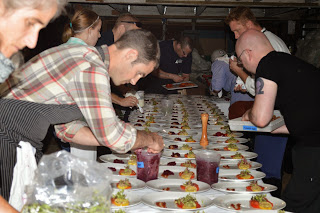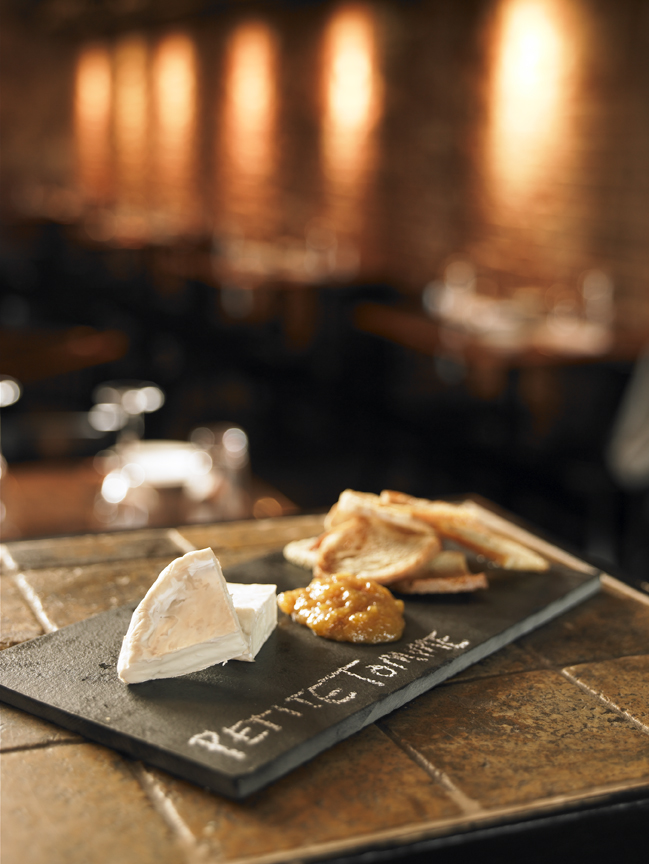Evan's Introduction to the fifth annual Heirloom Harvest Project Barn Dinner and a tribute to Chuck Cox from Tuckaway Farm
The seeds on your menu tonight are Boothby blond cucumber seeds that our
heirloom garden behind the barn grew out for this event. Please feel free to tear off the bottom of
this menu attachment and plant those seeds in your garden next year.
As
you look at this menu and as you experience this dinner, I hope you will be
thinking about the amount of time, energy and dedication that goes into
it. Chefs, farmers, volunteers from all
walks of life, from near and far, have made a personal sacrifice of their time
to make this event happen. Again and
again. Although the night is fleeting,
the effort is a year-round labor of love.
This
year more than ever, I am struck by how this dinner lies at the nexus of our
past and our future. Heirlooms linked to
our past tonight find themselves in the hands of some of the most creative
chefs you will ever find under one roof.
And, more importantly, when tonight is over, these chefs and a slew of
talented farmers will go back to work and continue to propagate this idea that
our food heritage is worth preserving, even as the world around us
changes. In fact, as last year’s
National Geographic cover story warned: heirlooms are necessary BECAUSE the
world around us changes.
 Like
the words “organic” and “sustainable”, the word “heirloom” gets bandied about a
lot and can certainly fall into the wrong hands--the nefarious hands of
exploiters, usurpers and opportunists who hope to hop on the bandwagon for a
joyride without understanding where the bandwagon has been or where it is
going. At Heirloom Harvest Project,
heirlooms are defined not as seeds gotten from a remote farmer in India who may
have saved seed from last year’s harvest of a weird looking cucumber that will
get oohs and ahhs at an American farmer’s market; heirlooms to us are a
culturally vital variety of fruit or vegetable that was seed-saved for many
generations of farmers in our region because of traits that made those plants
well suited to the challenges and vagaries of our climate and seasons. Many of these heirlooms haven’t been seen
outside of random home gardens since before World War Two. The participating Heirloom Harvest Project
farmers have divvied up our list of heirloom vegetables and grown them for
participating chefs to play with, Those chefs have applied both futuristic and
ancient technologies to these imperiled ingredients to create your dinner
tonight.
Like
the words “organic” and “sustainable”, the word “heirloom” gets bandied about a
lot and can certainly fall into the wrong hands--the nefarious hands of
exploiters, usurpers and opportunists who hope to hop on the bandwagon for a
joyride without understanding where the bandwagon has been or where it is
going. At Heirloom Harvest Project,
heirlooms are defined not as seeds gotten from a remote farmer in India who may
have saved seed from last year’s harvest of a weird looking cucumber that will
get oohs and ahhs at an American farmer’s market; heirlooms to us are a
culturally vital variety of fruit or vegetable that was seed-saved for many
generations of farmers in our region because of traits that made those plants
well suited to the challenges and vagaries of our climate and seasons. Many of these heirlooms haven’t been seen
outside of random home gardens since before World War Two. The participating Heirloom Harvest Project
farmers have divvied up our list of heirloom vegetables and grown them for
participating chefs to play with, Those chefs have applied both futuristic and
ancient technologies to these imperiled ingredients to create your dinner
tonight.

Tonight
is the capitulation of a year-long project.
Each February, all participating Heirloom Harvest Project chefs and
farmers convene in one room. We discuss
the selected heirloom crops, assign and distribute heirloom seeds to the
farmers, and determine the theme for the year.
This year, my wonderful wife Denise suggested, “Hey why not do an all
vegetable Dinner?” I looked around the
room, expecting boos, rotten tomatoes and general rebellion. But the response among chefs and farmers was
overwhelmingly in favor of this idea.
This
is funny because, if any of you have seen NH Chronicle’s coverage of this event
from two years ago, you may recall that I said on camera something to the
effect of, “None of these chefs would make a vegetarian dinner in their
restaurant if you held a knife to their throat.” I actually said that, and I said it
defensively with some hubris because I was being pigeonholed as a
quote “organic hippie” by the interviewer. I now realize the interviewer may not have
been too far from the truth.

Since
then, my perspective has changed. I’ve
done some research and some soul searching. If I hear one more scientist publish findings
that a plant-based diet can improve health, and all but eliminate childhood
obesity, type 2 diabetes and many types of cancer, I might have to start
holding a knife to my own neck. But then
I think about bacon, barbecue, an occasional juicy burger, and the most
sinfully unforgivable of pleasures, foie gras… Eating your veggies, just like
Mom used to tell us, is a tough lifestyle choice for sure, like quitting
anything, but if we know it can change the world, why don’t more people
practice it? Most everyone in this room
has seen the documentaries about how America’s factory farming meat industry
works. We have heard the refrain, “how
we are going to feed an 8 billion person world?”
To
greatly oversimplify this conundrum, I have narrowed it down to two schools of
thought.
First,
there The Monsanto way, embraced by massive farming operations like Salinas,
California, where you create the perfect Aryan vegetable or Frankenfruit
through genetic alterations and chemical inputs that may or may not include
putting animal genes in vegetables and much worse. This way means planting bajillions of acres
of a single crop and spraying the bejeesus out of so that chemical manufacturers
continue to be the lords of the farmland fiefdom. We can follow this path and be like the state
of Kansas.
From a
very recent article I came across,”
Kansas’s “Committee on Energy and Environment” is proposing a law
(currently known as House Bill No. 2366) that
would ban all state and municipal funds for anything related to
“sustainable development,” which it defines as: “development in which
resource use aims to meet human needs while preserving the environment so that
these needs can be met not only in the present, but also for generations to
come."
If this
definition sounds familiar, that’s because it was lifted verbatim from what’s
commonly referred to as the Brundtland Report,
one of the seminal documents in the modern practice of sustainability. The
Brundtland Report was the product of a four-year commission set up by United
Nations member countries that were increasingly concerned that the world’s
resources were being squandered and its environment spoiled.
You
know what? We’re not in Kansas
anymore! And while we recognize that and
pat ourselves on the back for it, we must also recognize that we are still in the
minority in our own country—and even in our own region--because our connection
to our food and the security of its future are sacred to us.
So
this is the first way to approach feeding the world. The other way, instead of mega-monocrop
farmland dominating the American landscape, is to put more diverse food in the
ground in more places that provide a suitable climate for that food. We are
going to need a billion backyard gardens to feed 8 billion people. Some people say that’s impossible. I think it’s easy. But billions of people have to get it, and
we’re only a small fraction of the way there.
So
this year, politics aside (well almost) we have chosen a vegetarian theme for
the Barn Dinner, not to spite meat and fish, but to highlight the incredible
diversity of heirloom vegetables and preparations for them. We are getting back
to our figurative and literal roots by putting the focus back on the vegetables
that started this event in the first place.
When
I was approached in 2007 by Chefs Collaborative, a nationwide organization I
now sit on the Board of, they introduced me to RAFT (Renewing America’s Food
Traditions, a now-dormant initiative whose mission continues through the work
of Slow Food USA.). Over the years,
numerous local food-based orgs and masses of volunteers have contributed to
this one night of the year.
Specifically, Slow Food Seacoast, Seacoast Eat Local, Seacoast Local,
our regional colleges, universities and secondary educational
institutions.
This
dinner has spawned others like it, near and far. Our growth is humble, organic and effective,
and you all make it possible.
Out
of this dinner was born Farm-a-Q.
Farm-a-Q
was born to bring the idea of this dinner to a wider audience that includes
families and friends that might not be able to afford the experience you are
about to enjoy. If you look at your
almanac, you can pick the hottest, most humid day in early summer, and that is
sure to be the date for next year’s Farm-a-Q.
What
amazes me most about Heirloom Harvest Project’s two events is that their
success relies primarily on two of the busiest, most stressed out professions,
farmer and chef. Please join me in
loudly thanking the farmers and chefs who came together for you all tonight.
This
event set out to:
Reintroduce
heirlooms to farmers
Introduce
chefs to farmers –
Introduce
consumers to the farmers and chefs who grow, produce and prepare our local food
Our
wish was to protect our food heritage while strengthening community, preserve
biodiversity, and encourage growth of this idea to other communities.
In
my role as cofounder of Heirloom Harvest Project, I have responded to many
emails from as far away as Kenya, where a gentleman named Alex Kiprop has begun
his own “heirloom harvest project” to ensure that some of the fruits and grains
indigenous to his area are not forgotten in the wake of the introduction of GMO
monoculture crops like wheat and corn.
In a country that faces greater adversity than we could comprehend, his
efforts have succeeded, and he has introduced legislation to protect farmland
from pernicious outside interests.
One
of the founding fathers of the idea of biodiversity in our local food system, a
mentor and friend to many of us, and a resource whose patience and energy know
no bounds, is John Forti. As a Board chair for our local Slow Food Seacoast
chapter, John will continue our annual tradition of kicking this dinner off
with an inspiring non-ecumenical benediction....
Tribute to Chuck Cox of
Tuckaway Farm
Jeff
McCormack, founder of Southern Exposure Seed Exchange in Virginia, put it very
well when he said, “Culture and agriculture are inextricably intertwined. They are two sides of the same coin.” Perhaps
no one in our community better represents this wisdom than the farmer we have
chosen to receive a very specific donation from the proceeds of last year’s
Heirloom Harvest Project events.
Never
wavering from the image we all have of the noble farmer, whether he is fox
hunting or working the land with his draft horses, milling flint corn in his
dining room or lecturing about the fragility of our foodways, Chuck Cox and his
bountiful, organic land continue to represent the ideas that have rebuilt our
local food system, and he has not stopped with mere action. He has educated all of us—chefs, farmers,
consumers, politicians, and the next generation of his own amazing family—about
what it means to create true sustainability in our foodways. At Heirloom Harvest Project, we want to
ensure that his vision will be an heirloom for generations to come.

With
a portion of the proceeds from last year, we were able to purchase a device
that we think will help close the loop in our food system. It is advertised on eBay as a “20# Coffee,
peanut Chile Cacao Roaster,” but the Coxes are not going to use it for any of
those purposes. They will use it to
roast corn and flower seeds to produce oils and flour that can be used by chefs
and consumers in our community for years to come. Because we don’t have large parcels of land
dedicated to grains and flowers for oil production, we in our community still
rely on imported oils, a large part of our diet and culinary larder, but a tool
such as this changes the rules of that game a little. A very little. But it is a step in the right direction. And it couldn’t be in better hands than the
Cox family, who have served as mentors for so many of us as we ponder our own
roles in the future of our foodshed.
Eleanor Mallett's (13) rallying cry for the next generation
My name is
Eleanor Mallett and I am in love with food. My brother Cormac and I were born
and raised to respect what we eat.
I love the
barn dinner because it brings together the farmers, chefs, and
eaters-of-the-food around the same table, to celebrate our food and all
that went into it. It is a spectacular thing to be able to know the people who
grow the food that is on my plate at dinner time. After all... it takes a
village to raise a Jimmy Nardello Pepper, if you know what I mean.
This is an
incredible evening. But, look around the room. How many kids do you see
here? Thats right, not many. Almost 74 million Americans are under 18 years
old.
I am here to
tell you all, that if my generation does not know about food biodiversity or
the importance of understanding where our food comes from, then all of your
work is lost.
Tell your
friends, tell your family, tell your children and your grandchildren. Spread
the knowledge that you have learned --> to us kids.
We want to
make an impact on the future.
The children
of today are the producers of tomorrow. We need farmers, we need buyers, we
need seed savers, we need home cooks, educators, leaders, chefs, and consumers.
It takes all of our voices -- and choices! -- to make a difference. Thank you.














